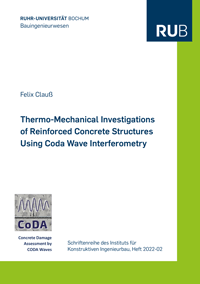
Shop : Details
Shop
Details
49,80 €ISBN 978-3-8440-8698-0Softcover224 pages125 figures332 g21 x 14,8 cmEnglishThesis
August 2022
Felix Clauß
Thermo-Mechanical Investigations of Reinforced Concrete Structures Using Coda Wave Interferometry
Civil engineering structures are aging. Ultrasonic coda waves offer an auspicious opportunity to monitor this deterioration. Current approaches with coda wave-based monitoring of concrete (structures) focus on specimens that are only a few centimeters small or on detecting cracks in reinforced concrete. The empirical model introduced in this thesis enables evaluating the load-bearing capacity of reinforced concrete structures subjected to bending using coda waves. The model involves the complex material behavior of reinforced concrete, from the linear-elastic range to the range of cracking and completed cracking.
The underlying methodology is based on mechanical, thermal, and thermo-mechanical experiments on reinforced concrete beams. Ultrasonic measurements are evaluated using coda wave interferometry. This method yields the relative velocity change. The strain of the component is used as a reference. Investigations into the application, assembly and accuracy of strain measurement techniques reveal fiber optics as a suitable technique.
The relative velocity change is correlated with the measured strain. The idea is based on the volume-like collection of influences by coda waves. The correlation of the two respective quantities (relative velocity change and average steel strain) exhibits a linear relationship. This gives a first-order approach. Using this approach, the strain of the beam can be accurately calculated via the relative velocity change. Statistically, the model is of high quality (R^2 = 0.99) and low error (RMSE = 0.09 ‰).
Consequently, it becomes feasible to monitor reinforced concrete structures by means of ultrasonic measurements and to accurately indicate the load-bearing capacity even under progressive cracking.
The underlying methodology is based on mechanical, thermal, and thermo-mechanical experiments on reinforced concrete beams. Ultrasonic measurements are evaluated using coda wave interferometry. This method yields the relative velocity change. The strain of the component is used as a reference. Investigations into the application, assembly and accuracy of strain measurement techniques reveal fiber optics as a suitable technique.
The relative velocity change is correlated with the measured strain. The idea is based on the volume-like collection of influences by coda waves. The correlation of the two respective quantities (relative velocity change and average steel strain) exhibits a linear relationship. This gives a first-order approach. Using this approach, the strain of the beam can be accurately calculated via the relative velocity change. Statistically, the model is of high quality (R^2 = 0.99) and low error (RMSE = 0.09 ‰).
Consequently, it becomes feasible to monitor reinforced concrete structures by means of ultrasonic measurements and to accurately indicate the load-bearing capacity even under progressive cracking.
Keywords: Codawellen; Korrelation; Dehnung; Relative Geschwindigkeitsänderung; Thermomechanisch; Momenten-Krümmungsbeziehungen; Structural Health Monitoring; Stahlbeton;
Schriftenreihe des Instituts für Konstruktiven Ingenieurbau
Edited by Prof. Dr.-Ing. R. Breitenbücher, Prof. Dr.-Ing. Rüdiger Höffer, Univ.-Prof. Dr. Markus Knobloch, Univ.-Prof. Dr.-Ing. habil. Peter Mark and Prof. Dr.-Ing. Markus Thewes, Bochum
Volume 2022,2
Available online documents for this title
You need Adobe Reader, to view these files. Here you will find a little help and information for downloading the PDF files.
Please note that the online documents cannot be printed or edited.
Please also see further information at: Help and Information.
Please also see further information at: Help and Information.
| Document |  | Document | ||
| Type |  | |||
| Costs |  | 37,35 € | ||
| Action |  | Purchase in obligation and download the file | ||
| Document |  | Table of contents | ||
| Type |  | |||
| Costs |  | free | ||
| Action |  | Download the file | ||
User settings for registered online customers (online documents)
You can change your address details here and access documents you have already ordered.
User
Not logged in
Export of bibliographic data
Shaker Verlag GmbH
Am Langen Graben 15a
52353 Düren
Germany
Am Langen Graben 15a
52353 Düren
Germany
Mon. - Thurs. 8:00 a.m. to 4:00 p.m.
Fri. 8:00 a.m. to 3:00 p.m.
Fri. 8:00 a.m. to 3:00 p.m.
Contact us. We will be happy to help you.



